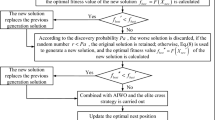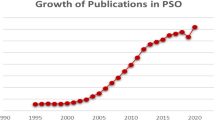Abstract
In this study, bee colony optimization (BCO) algorithm is adapted to the current control strategy of power factor correction for interleaved converter. The control approach is developed to eliminate the input current harmonics in the converter. BCO algorithm is a population-based new search algorithm which is one of the meta-heuristic techniques based on swarm intelligence. This algorithm simulates the natural behavior of real honey bees. In this approach, duty ratios are generated by BCO algorithm for the interleaved converter switches to obtain unity power factor (UPF) and lower total harmonic distortion of input current. The duty ratios for half a line period are calculated and stored in a look-up table. By synchronizing the memory with the line, near UPFs can be achieved in an operating point. The feed forward is also used into the control algorithm by rms value of the input voltage. The implementation of feed forward improves the converter performance. The input current of converter is operated in continuous conduction mode. The simulation and experimental results show that the proposed control strategy works well and the UPF can be achieved with a wide input voltage and load variation. The results are compatible with IEC 61000-3-2 Current Harmonic Standard.















Similar content being viewed by others
Abbreviations
- ADC:
-
Analog digital converter
- BCO:
-
Bee colony optimization
- CCM:
-
Continuous conduction mode
- DSP:
-
Digital signal processor
- \(D_{d}\) :
-
Duration dance of bees
- \(E_{b}\) :
-
Elite bee
- Hi:
-
Inner loop
- Hv:
-
Outer loop
- m:
-
Best bees
- Ni:
-
Number of iteration
- PI:
-
Proportional and integral
- PFC:
-
Power factor correction
- PWM:
-
Pulse width modulation
- THD:
-
Total harmonic distortion
- UPF:
-
Unity power factor
References
Simone B et al (1998) Simple digital control improving dynamic performance of power factor pre-regulators. IEEE Trans Power Electron 13(5):814–823
Karaarslan A, Iskender I (2011) A DSP based power factor correction converter to reduce total harmonic distortion of input current for improvement of power quality. Electr Eng 93(4):247–257
Sun B, Ye Z (2011) Digital control improves bridgeless PFC performance. Texas Instrum 1:20–24
Zhang W et al (2004) A digital power factor correction (PFC) control strategy optimized for DSP. IEEE Trans Power Electron 19(6):1474–1485
Karaarslan A, Iskender I (2009) Pure sinusoidal input voltage based bridgeless PFC converter using TMS320F2812 digital signal processor. In: Electrical and electronics engineering, ELECO’09 international conference, vol 1, pp 234–238
Pham DT et al (2005) The bees algorithm. Technical Note Manufacturing Engineering Centre, Cardiff University, UK
Karaboga D (2005) An idea based on honey bee swarm for numerical optimization. Technical report TR06. Erciyes University, Engineering Faculty, Computer Engineering Department
Nakrani S, Tovey C (2004) On honey bees and dynamic allocation in internet hosting centers. Adapt Behav 12(3–4):223–240
Alonso JM, Dalla Costa MA, Ordiz C (2008) Integrated buck-flyback converter as a high-power-factor off-line power supply. IEEE Trans Ind Electron 55(3):1090–1100
Zhang Jun DDC, Ting Lu Sun (2010) Flyback-based single-stage power-factor-correction scheme with time-multiplexing control. IEEE Trans Ind Electron 57(3):1041–1049
Balestero JPR et al (2012) Power factor correction boost converter based on the three-state switching cell. IEEE Trans Ind Electron 59(3):1565–1577
Mahdavi M, Farzanehfard H (2011) Bridgeless SEPIC PFC rectifier with reduced components and conduction losses. IEEE Trans Ind Electron 58(9):4153–4160
Yao-Ching Hsieh, Te-Chin Hsueh, Hau-Chen Yen (2009) An interleaved boost converter with zero-voltage transition. IEEE Trans Power Electron 24(4):973–978
Yao Gang, Chen Alian, He Xiangning (2007) Soft switching circuit for interleaved boost converters. IEEE Trans Power Electron 22(1):80–86
Hsieh Y-C, Hsueh T-C, Yen H-C (2009) An interleaved boost converter with zero-voltage transition. IEEE Trans Power Electron 24(4):973–978
Yungtae J, Jovanovic MM (2007) Interleaved boost converter with intrinsic voltage-doubler characteristic for universal-line PFC front end. IEEE Trans Power Electron 22(4):1394–1401
UC3854AN—Advanced high power factor pre-regulator, Texas Instruments (online). http://www.ti.com/lit/ds/symlink/uc3854.pdf
Todd PC. UC3854 Controlled power factor correction circuit design, U-134, Unitrode Application Note, pp 269–288. http://www.ti.com/lit/an/slua144/slua144.pdf
Pham DT et al (2010) Using the bees algorithm to tune a fuzzy logic controller for a robot gymnast. Manufacturing Engineering Centre, Cardiff University, Cardiff, UK
Karaarslan A (2013) The implemantation of bee colony optimization algorithm to Sheppard–Taylor PFC converter. IEEE Trans Ind Electron 60(9):3711–3719
Karaarslan A (2013) The analysis of average sliding control method applied on Sheppard–Taylor power factor correction converter. Electr Eng 95(3):255–265
Karaarslan A, Iskender I (2013) Analysis and comparison of current control methods on bridgeless converter to improve power quality. Int J Electr Power Energy Syst 51(1):1–13
Karık F, Iskender I, Karaarslan A, Genç N (2014) Performance analysis of interleaved single-phase rectifier using different current control methods. J Fac Eng Archit Gazi Univ 29(3):443–450
Karaarslan A, Iskender I (2011) DSP microprocessor based-on power factor correction to improve power quality of converters using predictive control. Int Rev Electr Eng 6(2):512–521
IEC Standard 61000-3-2 (2009) Electromagnetic compatibility (EMC), limits for harmonic current emissions (equipment input current \(\le 16\text{ A }\) per phase). Part 3–2 (online). http://www.rfemcdevelopment.eu/index.php/en/emcemi-standards/en-61000-3-2-2006-a1-a2
Author information
Authors and Affiliations
Corresponding author
Rights and permissions
About this article
Cite this article
Karaarslan, A. The implementation of bee colony optimization control method for interleaved converter. Electr Eng 98, 109–119 (2016). https://doi.org/10.1007/s00202-015-0348-z
Received:
Accepted:
Published:
Issue Date:
DOI: https://doi.org/10.1007/s00202-015-0348-z




